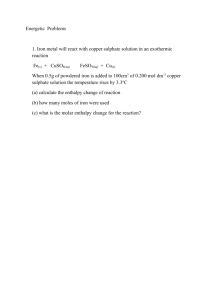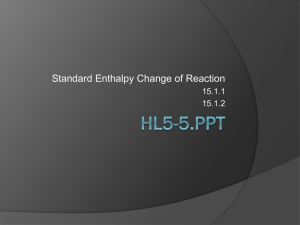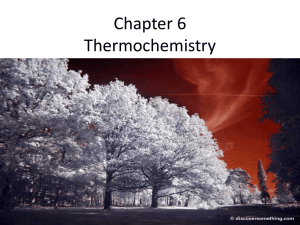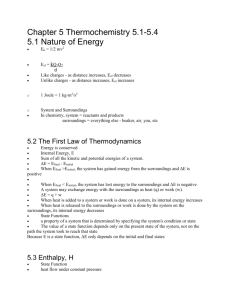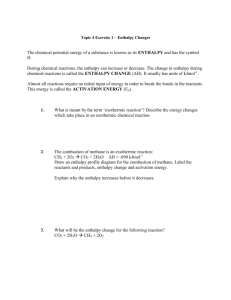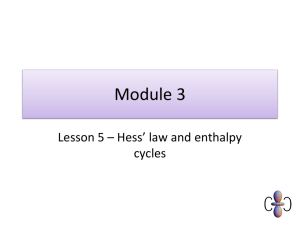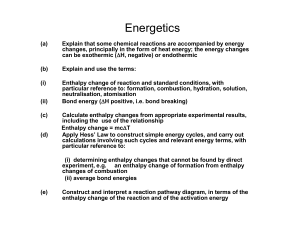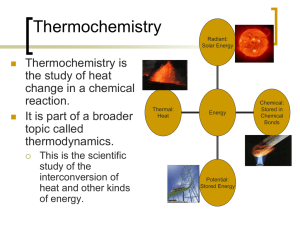5.2 b) HESS`S LAW AND STANDARD ENTHALPIES OF REACTION
advertisement
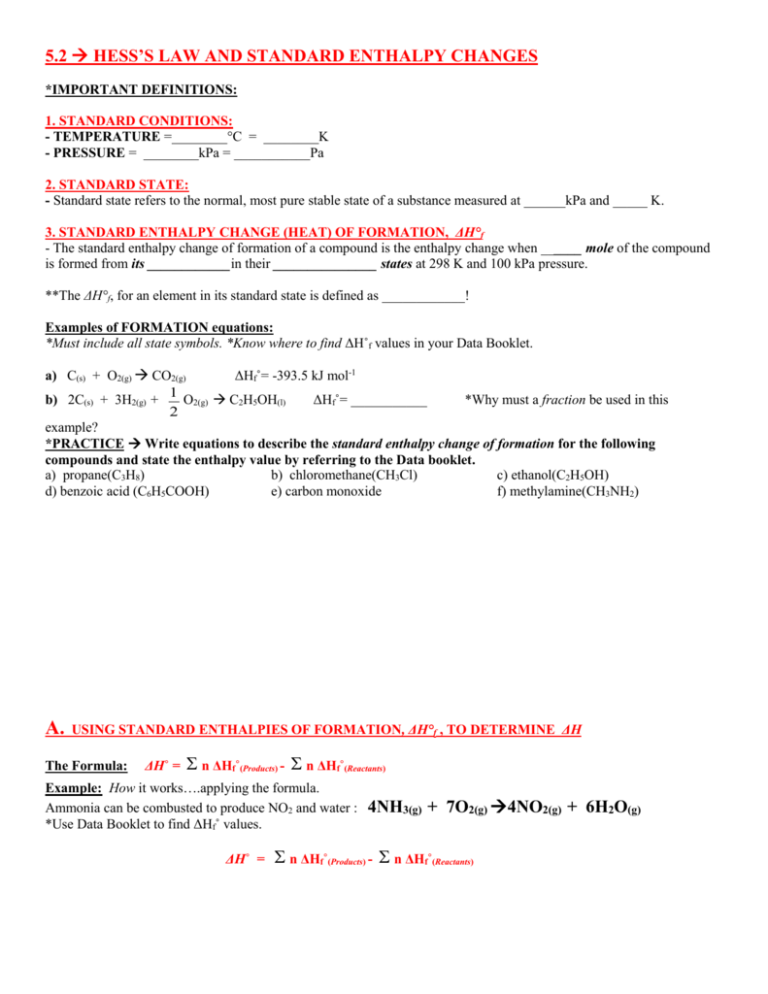
5.2 HESS’S LAW AND STANDARD ENTHALPY CHANGES *IMPORTANT DEFINITIONS: 1. STANDARD CONDITIONS: - TEMPERATURE =________°C = ________K - PRESSURE = ________kPa = ___________Pa 2. STANDARD STATE: - Standard state refers to the normal, most pure stable state of a substance measured at ______kPa and _____ K. 3. STANDARD ENTHALPY CHANGE (HEAT) OF FORMATION, ΔH°f - The standard enthalpy change of formation of a compound is the enthalpy change when ______ mole of the compound is formed from its ____________in their _______________ states at 298 K and 100 kPa pressure. **The ΔH°f, for an element in its standard state is defined as ____________! Examples of FORMATION equations: *Must include all state symbols. *Know where to find ΔH˚f values in your Data Booklet. a) C(s) + O2(g) CO2(g) ΔHf˚= -393.5 kJ mol-1 1 b) 2C(s) + 3H2(g) + O2(g) C2H5OH(l) ΔHf˚= ___________ *Why must a fraction be used in this 2 example? *PRACTICE Write equations to describe the standard enthalpy change of formation for the following compounds and state the enthalpy value by referring to the Data booklet. a) propane(C3H8) b) chloromethane(CH3Cl) c) ethanol(C2H5OH) d) benzoic acid (C6H5COOH) e) carbon monoxide f) methylamine(CH3NH2) A. USING STANDARD ENTHALPIES OF FORMATION, ΔH°f , TO DETERMINE ΔH The Formula: ΔH˚ = n ΔHf˚(Products) - n ΔHf˚(Reactants) Example: How it works….applying the formula. Ammonia can be combusted to produce NO2 and water : *Use Data Booklet to find ΔHf˚ values. ΔH˚ = 4NH3(g) + 7O2(g) 4NO2(g) + 6H2O(g) n ΔHf˚(Products) - n ΔHf˚(Reactants) Example: Why it works…the details. Consider the reaction of lime(calcium oxide) and water to form calcium hydroxide: CaO(s) + H2O(l) Ca(OH)2(s) The Formula Represented As An Enthalpy Cycle: B. USING STANDARD ENTHALPIES OF COMBUSTION, ΔH°C, TO DETERMINE ΔH DEFINITION 1 . STANDARD ENTHALPY CHANGE (HEAT) OF COMBUSTION, ΔH°C - The standard enthalpy change of combustion is the enthalpy change when _________ mole of the substance is completely combusted in oxygen under standard conditions (298 K and 100 kPa pressure). *PRACTICE Write equations to describe the standard enthalpy change of combustion for the following compounds and state the enthalpy value by referring to the Data booklet. a) octane(C8H18) d) glucose (C6H12O6) b) cyclohexanol (C6H12O) c) methanoic acid(CH2O2) e) chloroethane (C2H5Cl) *Hint: a corrosive strong acid is one of the products The Formula: ΔH˚ = n ΔHc˚(Reactants) - n ΔHc˚(Products) Example: How it works….applying the formula. Use ΔH°C values from your data booklet to determine the enthalpy of reaction for the hydrogenation of ethane. C2H4(g) + H2(g) C2H6(g) ΔH˚ = n ΔHc˚(Reactants) - n ΔHc˚(Products) Example: Why it works…the details. 2C(s) + 3H2(g) C2H6(g) The Formula Represented As An Enthalpy Cycle:

